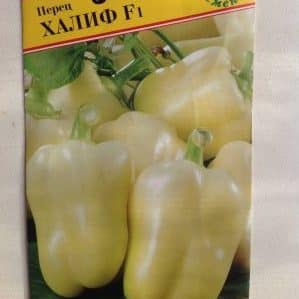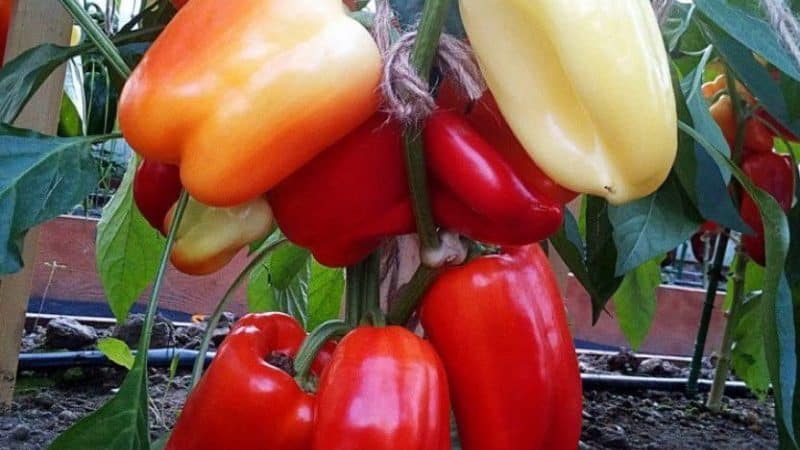Early ripening and high-yielding hybrid of pepper "Kalif" (Khalif) from Japanese breeders
Pepper Kalif (Khalif) is cold-resistant and unpretentious. Hybrid Suitable for growing in regions with sudden weather changes, heat and drought. It is planted in greenhouses, hotbeds or open ground. Peppers make tasty and healthy dishes - the flesh is tender and sugary.
Let's look further at the description of the Calif pepper and find out how to grow a rich harvest on your site.
What kind of pepper is this
Sweet Kalif pepper is the result of the work of Japanese breeders. Thanks to its taste, it has become widespread throughout the world.
Hybrid f1

The hybrid shows resistance to the main diseases of the crop - tobacco mosaic, powdery mildew, root rot. Unpretentious, rarely exposed to pests and weeds.
It bears fruit for a long time and sets fruit in any climatic conditions.
Distinctive features
Early ripening, ripens within 90 days from the appearance of the first shoots. The bushes are miniature, about 50-60 cm in height. The leaves are green, medium in size. The shoots are short and powerful.
Fruit characteristics and yield
The fruits are large, the weight of one varies from 180 to 210 g. The shape is prism-shaped, elongated. The wall thickness is 9 mm, which allows the peppers to be used for long-term storage. The pulp is fleshy and sweet.
It is universal in use, the yield is stable - 8-10 fruits from one bush.
Preparation for cultivation
Seed material is purchased in trusted stores; upon purchase, the expiration date of the seeds, the manufacturer, and the integrity of the packaging are studied. At home, the seeds are inspected for defects; specimens with stains or scratches are thrown away. The remaining seeds are checked for germination - placed in a jar of water and salt (50 g of salt per 1 liter of water) and stirred clockwise. The seeds that sink to the bottom are used for planting.
Seed disinfection is carried out using a solution of potassium permanganate, aloe juice or Bordeaux mixture. The seeds are placed in a fabric bag and dipped in liquid for 20 minutes, taken out and dried on a clean towel. They can also be disinfected using the oven - place on a baking sheet and put in the oven for an hour at a temperature of +180°C.
Important! After disinfection, the material is germinated - placed in damp gauze and put in a warm place for two days. To accelerate development, the growth stimulator “Kornevin” is added.
Hybrid Kalif is grown in seedlings, so prepare the container and soil in advance. Any dry and clean container is suitable - flower pots, peat cups, wooden boxes. Ready-made soil from the store or soil from the garden are used as soil. The soil is fertilized with manure, compost or humus, and clean river sand is added for looseness.
Growing seedlings

Seedlings are prepared at the end of March. The containers are filled with soil and grooves are made 1 cm deep. Place 1-2 seeds in each hole, sprinkle soil on top and water with warm water.
Store seedlings in a warm and sunny place; sweet peppers are a heat-loving crop. If there is a lack of natural sunlight, phytolamps are purchased.
Watered seedlings as the soil dries, approximately once every 4-6 days.It is important to prevent the soil from becoming waterlogged, which can lead to fungi and viruses. Two weeks after planting, fertilizing with manure or chicken droppings is organized. The next time the fertilizer is applied after 15 days, mineral components are used - superphosphate, potassium salt, ammonium nitrate.
Important! If the peppers are planted in small pots or cups, after a month the gardeners organize a pick, that is, they transplant the seedlings into a larger container. If this is not done, then the roots will not have enough space to grow and develop. Plant the sprouts carefully so as not to damage the fragile roots and leaves.
Planting pepper
The beds for peppers are prepared in the fall. The best predecessors are peas, corn, cabbage. It is not recommended to plant vegetables after potatoes or tomatoes. At the end of October, the soil is dug up, lumps and weeds are removed, and manure is added. In April, the soil is dug up again, cleaned of debris and leaves. Recommended planting pattern for Calif pepper 50x70 cm.
For planting, choose a cloudy, windless morning. Seedlings are placed in holes 3-5 cm deep, the base of the stem is slammed with earth and sprinkled with peat chips. After planting, the peppers are watered and straw is placed on the beds - it retains moisture and nourishes the young plants. In the first week, the bushes are covered with film or thin glass to protect them from winds and frosts.
Important! Before planting in the greenhouse, all walls and doors are wiped with a solution of succinic acid, the soil is watered with Bordeaux mixture, and the structure is ventilated.
Further care
Pepper Kalif requires timely care. It consists of fertilizing, watering and loosening the beds:
- About 2 liters of warm water are consumed per bush. In rainy weather, the beds are watered once a week, in dry and hot weather - once every 4-5 days.If the leaves curl, it means the plant does not have enough moisture, increase the volume of water. The best time for the procedure is early morning or evening to avoid sunburn and evaporation.
- Loosening helps get rid of weeds and prevent their appearance. The procedure makes the soil lighter and airier, improves the flow of oxygen to the roots. They loosen the beds once a week to a depth of 5-10 cm. In addition to the bushes, they also pay attention to the aisles where weeds often appear.
- During the ripening period, Kalif pepper is fertilized 2-3 times. Alternate organics and mineral complexes: potassium, phosphorus, droppings, urea, ash. The procedure is carried out every 15 days, after watering the soil. Fertilizers improve the taste of fruits, their presentation, and protect them from diseases and pests. For foliar feeding, spraying with Bordeaux mixture or nettle infusion is used.
Features of cultivation and possible difficulties
When growing a hybrid, it is important to observe the dosage of added microelements. Their excess or deficiency leads to leaf fall and fruit spoilage. When fertilizing, do not use fertilizers that contain chlorine - for example, ammonium chloride. It gets into the root soil and blocks the access of nutrients.
Preference is given to phosphorus-potassium fertilizers and nitrogen-containing substances. During flowering, they focus on organic matter - they feed with liquid manure.
Interesting! Fertilizing based on herbs is effective. A remedy is prepared from the flowers and leaves of plantain, hops and horsetail. The plants are crushed, poured with boiling water and left for several hours. After cooling, the bushes are watered at the root or the leaves are sprayed with a spray bottle.
If after flowering the ovaries fall off and the fruits stop growing, the bushes are treated with a solution of boric acid. It nourishes the roots and stem, strengthens the immune system and stimulates further development.
Typical diseases and pests

Despite the hybrid’s resistance to fungi and infections, it can get sick if not cared for properly.
The most dangerous diseases:
- Brown spot (cladosporiosis). Occurs due to contaminated soil, non-compliance with crop rotation rules, heat and high humidity. The stems and leaves become covered with brown spots, which increase in size over time. Spraying with whey is used as a preventive measure; for treatment, the professional drug “Zaslon” is used. Apply the product strictly in accordance with the dosage on the package.
- Black bacterial spot affects adult plants during the fruiting period. For prevention, use a soap solution or copper sulfate. If bacterial spotting appears, the affected bushes are removed from the garden bed and burned away from the area. The remaining plants are treated with a solution of potassium permanganate.
The Colorado potato beetle is a pest. The striped insect affects both young seedlings and adult bushes. Larvae and adults are dangerous. The Colorado potato beetle is able to live underground for up to two years and tolerates cold and low temperatures. It feeds on plant sap, which is why the pepper lacks vitamins for development. The drugs “Barrier” or “Tornado” help to cope with the pest.
Advantages and disadvantages of the variety
The advantages include high yield, unpretentiousness, immunity to diseases and pests. Peppers are distinguished by their commercial appearance; Kalif is grown for personal consumption and for sale.Vegetables are stored and transported for a long time, without losing their beneficial qualities and taste. This hybrid is planted outdoors, in greenhouses or greenhouses.
Interesting! Sweet Calif is valued for its versatility in use. Red glossy fruits are used to prepare vegetable stews, stuffed dishes, snacks and salads. Moderately juicy pulp goes harmoniously with meat and fish dishes; peppers are used fresh and marinated in jars for the winter.
The only negative is that the seedlings do not tolerate picking. This can be avoided: the seeds are immediately planted in large containers, in which the pepper seedlings develop before planting in open ground.
Reviews
What do Russian gardeners think about Kalifa? Here are a few reviews from popular online forums:
Marina, Izhevsk: “I have loved Pepper Khalif for a long time. I am attracted to compact bushes; they decorate the garden. I plant it in open ground and fertilize it with manure and potassium. The fruiting period is extended, the vegetables are well stored.”
Peter, Moscow region: “I didn’t like the Japanese Caliph. The bushes developed slowly, although I prepared the seedlings and dived in time. The fruits are large, but taste watery. I am disappointed".
Elizaveta, Krasnodar: “I planted the red-fruited hybrid Kalif for the first time. I was pleased with the large fruits and sugary pulp - I have never seen a sweeter pepper. This season I planted only one bed, next year I will set aside three for Kalif. The taste is amazing when fresh.”
Conclusion
Appetizing fruits will decorate any area. The hybrid is unpretentious in care; the main thing is to water and fertilize the plants on time. To obtain a rich harvest, they plant seedlings after clearing the beds of debris and weeds.
Caliph reacts favorably to mineral and organic fertilizing and is immune to diseases. Harvest in August, when the peppers become elastic and shiny, and the stalk is dry. Calif is used fresh or for making soups, side dishes and salads.